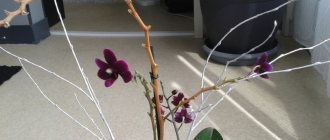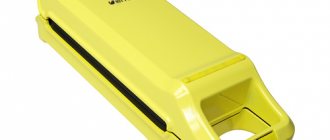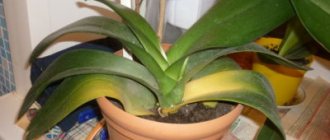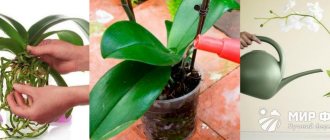Orchids, if properly cared for, will bloom profusely. Over time, the flowers dry out and gradually fall off on their own. Whether to cut this stem or not depends primarily on the type of orchid you have. How to properly prune an orchid after flowering will be described in this article.
An orchid is a plant that requires special attention and care. If you neglect this, the flower will stop growing and releasing buds. If you treat it correctly, it will delight you with flowers for a long time.
The orchid needs pruning after flowering. This will promote healthy growth and development.
Do I need to prune my orchid after flowering?
After the growing season, it is not always necessary to get rid of the peduncle. But you must wait until the period when you need to prune the orchid. Cupping begins only when it is completely dry. At this time, the plant is preparing for sleep. In the Russian climate, the ideal period is late autumn - late October - November.
Signs of imminent relief:
- yellowing, drilling of the flower-bearing arrow;
- drying out of the shoot;
- long period of rest (more than six months).
Important! One of the main criteria that all reserves have been used is the drying of the tip of the stem.
Many gardeners do not know how to prune an orchid for fear of harming it. But the correct procedure does not harm the plant, especially young flowers, but helps to accumulate energy reserves for the growing season.
Care
- First of all, you should pay attention to the roots. If the roots are rotten, then you need to remove the flower from the pot, shake off the soil, dip the roots of the plant in warm water (pre-prepare a basin with warm water).
- Then the roots are dried. Diseased leaves and roots are removed. You will learn how to trim the roots correctly here.
- If part of the root system remains, then such a plant can be planted again in a pot with soil. But now you will have to strictly follow the rules of caring for your orchid.
- The flower should be placed in the southwest or southeast. Avoid exposure to direct sunlight.
- The temperature should be 30–33 degrees during the day, 20–25 degrees at night.
- Avoid drafts.
- Water the plant very carefully. At first, it is better to limit yourself to spraying the soil.
- If there are no roots left, the stem can be planted in a pot with damp moss. And try to grow roots.
In this way, the orchid can be brought back to life.
Attention! The main cause of leaf disease is rotting of the root system, which can be caused by disease and excessive watering, as well as unsuitable conditions.
In order to properly care for an orchid, you need not only knowledge, but also experience. You need to take into account many factors, observe, look for information, and consult with experienced flower growers. The orchid is a capricious and delicate flower, but its beauty is worth the effort .
How to prune a faded orchid in different cases
For pruning an orchid after flowering, the most suitable phase is the “sleep” phase, when it has completely bloomed, the stems have dried out, and new buds do not appear. If you miss the favorable time, budding will begin again and the plant will weaken.
Important! The time of pruning depends on the type of flower and the condition of the peduncle.
Before trimming an orchid after flowering, you need to carefully examine the flower arrows. They should not have buds or swollen buds - “babies”.
Depending on the variety of orchid, determine how to prune it after flowering.
- The Ludisia cut is made at an angle and covered with activated carbon or iodine.
- The dried flower-bearing arrow of Vanda is trimmed, leaving a stump 2 cm from the base. You cannot cut off a wilted stem.
- Bletila, Miltonia, Miltoniopsis, Tselogina, Miltassia are cropped after the growing season.
- The Dendrobium pseudobulb is cut off after complete drying.
To understand how to properly prune an orchid, you need to find out its variety. The color, shape of buds, leaves, and height will tell you about the variety of phalaenopsis.
Peduncle with wilted flowers
If there are wilted but not dried flowers on the orchids, then there is no need to prune after flowering. Young buds may soon appear and shoots may form.
Note! Flowering on side shoots is less abundant.
To form “babies”, side arrows, it is allowed to trim the stem above the last bud.
The peduncle remained green
So should you prune your orchid after flowering if the stem is still green? As a rule, cupping is postponed. Usually, young buds and shoots appear on the arrow. The education period takes up to three months.
If there is a need to shorten the phalaenopsis, then the cut shoot is placed in a container with water to form “babies”. In the spring, stimulating cupping is carried out, but not completely. Cut the arrow at a height of 2 cm from the last bud. New “babies” will appear in the summer.
The peduncle has turned brown and dried out
If the arrow has turned brown or dried out, it is removed immediately, but only after making sure that the shoot is dry. The withered shoot supplies the phalaenopsis with nutrients accumulated during the growing season. This promotes growth and restoration of the flower.
If the shoot is dry, then it is removed at a distance of 2 cm from the outlet. A new arrow forms after a few months.
The peduncle has not completely dried out
How to trim orchids if the stem is not completely dry? If the arrow is only partially dry, you need to wait. Dormant buds can form new buds.
By pruning the plant early, there is a risk of delaying the appearance of buds for at least 6 months. If the shoot is partially dried out, the drying does not spread; only its dry part is cut off.
The peduncle has dormant buds and gradually fades
Only observing phalaenopsis will help you make the right decision. Dormant buds can release new buds and delight with flowers and “babies.”
The formation of shoots and buds is facilitated by cutting the peduncle 1.5 cm above the bud. But this method does not always “awaken” dormant buds.
Important! Pruning may delay the formation of new flower stalks. The plant spends its accumulated energy on supplying the old frog with nutrients.
Proper care and cropping guarantees regular budding and the “birth” of new shoots.
Plant life cycle
Leaves are the most important organ of a plant. Thanks to them, the orchid receives sunlight and air. It is by these that the condition of the plant is primarily determined. They are the first to signal that something is wrong with the flower. Based on the condition of the leaves, you can determine the onset of the disease and take timely measures.
The life cycle is the alternation of periods of growth and dormancy of a plant, as well as life expectancy. The lifespan of an orchid is from 1 to 5 years. Some varieties live longer.
The rest period has two phases:
- biological;
- forced.
The period of biological rest varies greatly among different species: from 3 weeks to 5 months. At this time the following happens:
- Growth maturation.
- Vegetative and flower buds are formed.
- The flower stores nutrients and prepares for the growth period.
If conditions are unfavorable, then the orchid goes into a stage of forced dormancy . Until conditions become more suitable. The growth period is characterized by increased growth, bud maturation and flowering.
During this period, the plant requires:
- Maximum illumination, but not direct sunlight.
- Sufficient watering.
- Feeding.
- Appropriate air temperature.
Important! Be sure to consider the life cycle of an orchid. Since at different periods it requires different care and conditions.
Pruning an orchid after flowering: basic rules
For the well-being of phalaenopsis, it is necessary to understand how to prune orchids after flowering. This will reduce the risk of injury and death.
If it doesn’t bloom for a long time, then perhaps there is an excess of green mass. In this case, remove excess greens in the following order:
- cut off the lower leaves first;
- the leaf is divided in half lengthwise and torn to the stem;
- tear off the greens from the base;
- wait until it dries out, postponing watering.
The same needs to be done with dried foliage. Young shoots or aerial roots form under it.
Tools
The main thing needed for the procedure is tools:
- garden pruner;
- stationery knife;
- alcohol.
Unlike scissors, pruning shears cause less damage to the flower shoot. To crop orchids, use a sharp utility knife, but before cutting, the tool must be disinfected, for example, with alcohol.
Disinfection
Disinfection of instruments is a mandatory stage of the procedure. This will prevent the phalaenopsis from becoming infected and dying. Secateur blades are treated with alcohol or chlorine.
Important! It is better to carry out disinfection with gloves to prevent skin burns from chlorine!
You can immerse the tool in boiling water for a few minutes.
Determining the location of the cut
Often the arrow grows long, and the buds are based on its tip. There are two outcomes of the situation:
- leave as is;
- trim the plant 2 cm above the active bud.
Usually, the arrow is cut off above the second bud of the flower-bearing arrow from the rosette.
Important! The closer the cutting point is to the rosette, the more abundant the budding of the side shoots.
After docking, phalaenopsis begins to bloom no earlier than 2 months later.
Slice processing
To reduce the risk of infection, the cut point must be treated. It is lubricated with a solution of brilliant green, iodine or covered with crushed activated carbon.
Sometimes the stem is hollow inside. When watering, water flows into the formed stump, which leads to rotting of the rosette and the entire phalaenopsis. To avoid death, the cut site is filled with beeswax.
How to distinguish healthy from sick?
- A healthy orchid leaf adheres firmly to the trunk and has a rich green, uniform color. There are some varieties that have spotted foliage, but they are not common. Healthy leaves are free of any defects, parasites or damage.
- Diseased leaves are withered, yellow, cracked, and fall off the central trunk. Most often they have brown and yellow spots over the entire surface. Even if everything is in order in appearance, the leaves can be infected with parasites that are located at the base or on the back of the leaf.
When will the flower bloom again after pruning?
Cupping is stressful for any plant. At this time, provide sufficient watering so that the soil does not have time to dry out, irrigate the leaves and substrate.
During the resting phase, phalaenopsis stores energy. At this time it is important to ensure:
- comfortable temperature conditions (16C⁰ at night, up to 24C⁰ during the day);
- moderate watering;
- large distance from radiators;
- diffused light source.
It is not recommended to change the location of the potty during the rest phase. This can not only cause stress, but also injure the flower. The only condition for moving is an uncomfortable atmosphere: too high a temperature, dry air, insufficient lighting. In this case, the leaves become wrinkled and turn yellow.
Water the flower with warm water, without getting it on the foliage. This will prevent rotting and disease. Spray it only during the day. It is important that the drops have time to dry before sunset.
If the correct conditions are observed, the vegetative period will begin 2-3 months after cropping.
Note! The dormant period differs depending on the type of phalaenopsis.
When is it necessary to remove all foliage?
The most common reasons why all foliage is removed from an orchid:
- failure to comply with maintenance rules;
- insufficient or excessive watering;
- various diseases in which the root rots;
- parasites that have spread throughout the plant.
List of diseases for which foliage is completely cut off:
- Brown rot - watery and light brown spots appear.
- Black rot - black spots on leaves due to parasites or low temperature.
- Root rot - leaves become covered with brown or brown spots, and the root system rots.
- Fusarium rot - leaf blades turn yellow.
- Gray rot - grayish-dark spots appear with fluff on them.
- Spotting - leaves begin to wither, soften, gradually turn black and eventually rot and fall off.
- Anthracnose - small brown spots with smooth edges appear on the leaf blade. If the disease is not treated, the spots grow over the entire leaf and the plant dies.
- Powdery mildew - a white powdery coating appears on the plates. The leaves will begin to wither and dry out. This disease leads to the complete death of the plant.
Pruning the leaves of an orchid is a rare procedure, and is carried out in extreme cases - if the flower needs to unload and if it is sick or infected with pests. With proper care and timely feeding, there is no need to trim the foliage.
cramped potty
If the orchid has dried out and looks sickly, the cause may also be unfavorable growing conditions.
When the plant has grown and most of the roots are already outside the pot, or are squeezed in it, the roots become deformed and dry, the penetration of moisture and nutrients is difficult, as a result the leaves turn yellow and begin to fall down. Transplant the phalaenopsis into a pot of a suitable size, dividing it if necessary, being careful not to damage the buds and flower stalks. After transplantation, the plant will quickly return to normal.
Natural and pathological causes
0
Source:
If a person purchased an orchid and immediately transplanted it, this indicates his inexperience. The flower needs to be given time to adapt. The quarantine period must last at least 14 days. An orchid in a state of vigorous flowering does not need to be replanted. There are natural and pathological reasons for the appearance of yellow leaves in this plant. The first include its age, “stress” during transplantation and the death of leaves during the growth of the orchid. The pathological ones include the following:
- lack of light;
- improper watering;
- damage by fungi, bacteria or pests;
- incorrect placement of the flower in the room;
- poor care;
- lack of space in the pot.











